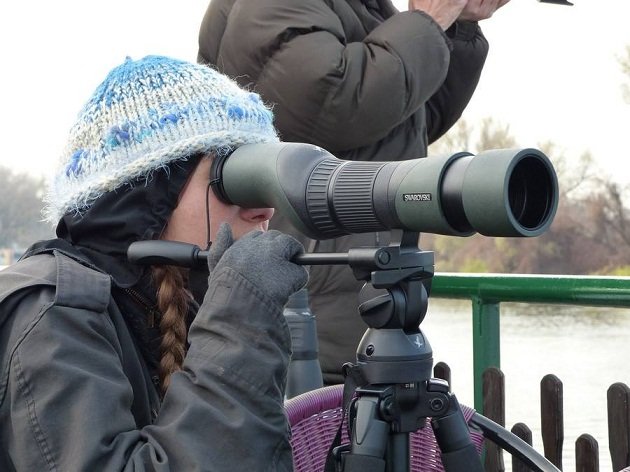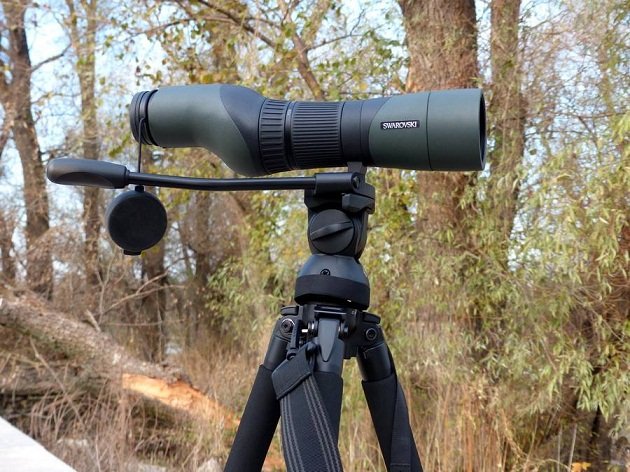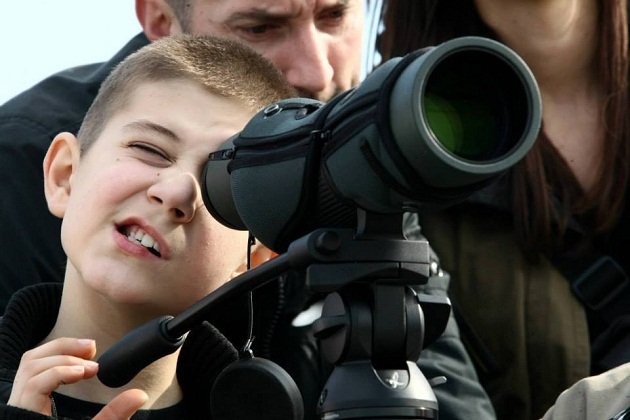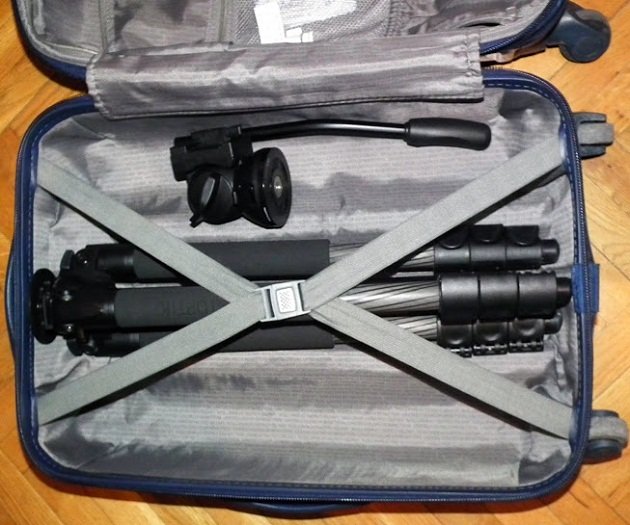
My best bird of the weekend was a Great Black-backed Gull, a rarity in a land-locked Serbia, with less than 10 observations so far. Could it be the same individual that I observed here last winter? It was at the same spot, but this time I have found a way to get much closer. At first, I made a few record shots, digiscoping through the Swarovski 25-60×65 STX with a hand-held mobile phone, until the battery went flat. The gull was showing no intention of moving, so I went home to collect a camera.
Later, it was interesting to compare the photos made by a smartphone and a camera with 30x zoom lens. Although I am using quite an old phone and should replace it any day, with a bit of help from Swarovski, it produced sharper images than my camera! Alright, it did focused on the weldings of the barge and not the bird, but it was still amazing. (I remember the reaction of my cousin, who is a professional photo journalist, when he took my Swarovski CL binoculars: “Bro, this is sooo sharp!”)
This is not my first spotting scope. I bought my first 20 years ago from some Russian on the seashore in Greece, but have not used it much because of rather dark images (I even took it to India with me – and didn’t use it even once). Later, I obtained one (West) German model which was way more expensive and still had the same problem, something I realised when I had the chance to compare it with a similarly priced Japanese model. Consequently, I carried it only when I absolutely had to (e.g. winter waterfowling at fish farms), but always preferred to leave it behind.
I like my equipment compact and lightweight. I am not ready to carry extra hundreds of grams, which easily turn into extra kilograms when you add a heavy and supposedly good tripod. And then, about a year ago, I had an eye-opening moment.
 Matched like G&T: Swarovski 25-60×65 STX scope + Swarovski CT Travel tripod
Matched like G&T: Swarovski 25-60×65 STX scope + Swarovski CT Travel tripod
That is when I got my hands on the Swarovski scope 25-60×65 STX, together with the carbon fibre Swarovski CT Travel tripod. Before I acquired my own Swarovski binoculars, I had the chance to test both ELs and CLs for months at a time and so, from my own experience I knew what level of quality this brand guarantees. Similarly, I had a good clue what to expect from the STX scope.
How to describe the experience in one word? Exciting! Ahmm.. in which way? In every way! Let’s try to define that “every way”. Extra sharp and very bright image is the first factor. It allowed me to start birding some surprisingly productive areas, even close to my home, that I had always avoided because the birds are too far away. For example, the Ada Huja Promenade in Belgrade. In front of it, the Danube reaches a kilometre in width and the birds congregate in the middle of the river, while the flocks of gulls in sunset fly above the other bank. Without a decent scope, going there is a waste of time, but ever since I discovered the STX, this place has become my regular winter patch and that is where I found that Great Black-backed Gull I mentioned at the start.
The choice of a scope reflects one’s approach to birding. Swarovski ATX/STX (angled/straight, respectively) modular scope system offers three interchangeable objective lenses, 65, 85 and 95 mm. The bigger the lens, the more light gathering power it has, but also heavier and bulkier it becomes. And, as I said before, I like my equipment lightweight and despite the obvious advantages of larger lenses, my choice was the 1585 grams / 55.9 ounces heavy 65 mm version. Ok, but the majority of birders use angled scopes – why the straight one? I am quite active in winter months and then I prefer to bird from the warm cocoon of a car. In such cases, I use a lightweight window clamp instead of a full-sized tripod and it is hard to impossible to use an angled scope in that position (and am really sorry that Swarovski is not making window clamps). Also, I find it easier to locate birds with a straight barrel – especially in the sky.
The period when I was regularly in touch with the best scopes was a decade ago, when I lived in the south of Arica. Back then I was quite reserved towards scopes with variable magnification (zoom) – the experience my own scopes have only cemented. The best one back then was Leica of my dear friend and a very experienced ornithologist. She carried two separate eyepieces, I believe they were 20x and 30x and most of the time she used the lower magnification. And I learned the lesson: in accordance with the laws of optic, fixed focal length is always superior. But in the meantime, a lot of water passed under the bridges of Belgrade…
There is one more aspect of scope use, harder to describe because it is something personal, a relative sense of comfort, coming partially from easiness of focusing and, yes, zooming. And the ATX/STX models do have an ergonomic advantage in this aspect. The rule with older models was that the focusing is somewhere in front, close to the middle of the barrel, while the zoom ring was at the eyepiece, so your hand goes 4-5 inches back and forward all the time. At ATX/STX, both rings are at the waist of the barrel, so in theory, one may manipulate both with two fingers at the same time, but I do move my index finger a comfortable inch forward and backward, keeping an eye on the bird all the time. It works well with the naked scope, but over time, I dressed mine into a protective sleeve, which somewhat restricts the finger movements (but not much).
 When you want to test your new scope, it is always a good idea to ask a bunch of primary school kids to – play with it (a nerve-wracking idea, too).
When you want to test your new scope, it is always a good idea to ask a bunch of primary school kids to – play with it (a nerve-wracking idea, too).
Did I said “extra sharp” image? It is not merely sharpness of image, but sharpness from-edge-to-edge right up to 60x magnification! Alright, there are situations when even that does not help, e.g. while counting swans a mile away with lower magnification and then zooming up to 60x to establish if they were Mute Swans or rarer Whooper Swans – through all the air shimmering above the water on a sunny winter day! No, that was too much to ask for.
Like my friend with two scope eyepieces, 90 per cent of the time I use the lowest magnification, in this case 25x, but I admit finding it useful to zoom up when I need it. Back to that Great Black-backed Gull, with 60x I observed the colour of its eyes at 100 metres – dark-orange.
In conclusion, for the first time I have a scope that I often, almost always, carry with me. And I want to carry it even when I can do without!
Finally, a trusty sidekick: Swarovski CT Travel tripod is hard and robust, yet lightweight (2 kg / 69 oz) and compact, made for frequent travelers. And this year I carried it to Greece twice, both by plane and by car. The second needs no additional comment, but the first – when you separate head from the legs, it easily fits into the cabin-sized luggage! I am 6.2 tall and find this tripod easy to use – it can extend a bit more than I need. What I like the most about it is the possibility of connecting the foot of the scope directly onto the tripod head, instead of a quick-release plate, making the connection very stiff, without a slightest trace of any wiggle.














Man, that is a beautiful little scope.
I was considering to describe it as “sexy”, but was worried that it sounds too geekish 😉
It’s so great when I can find such the detailed reviews from the people who had used it. All the hunting scopes enthusiasts should know your reviews. Thanks so much